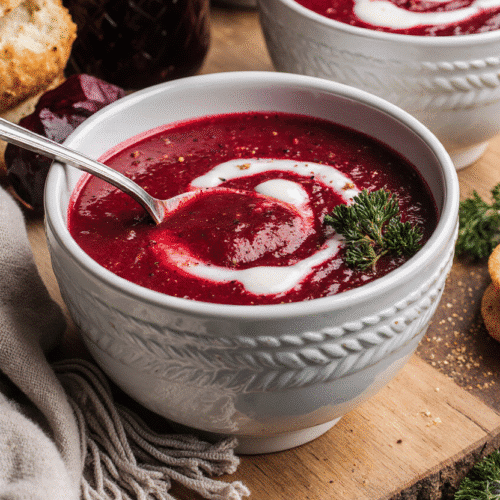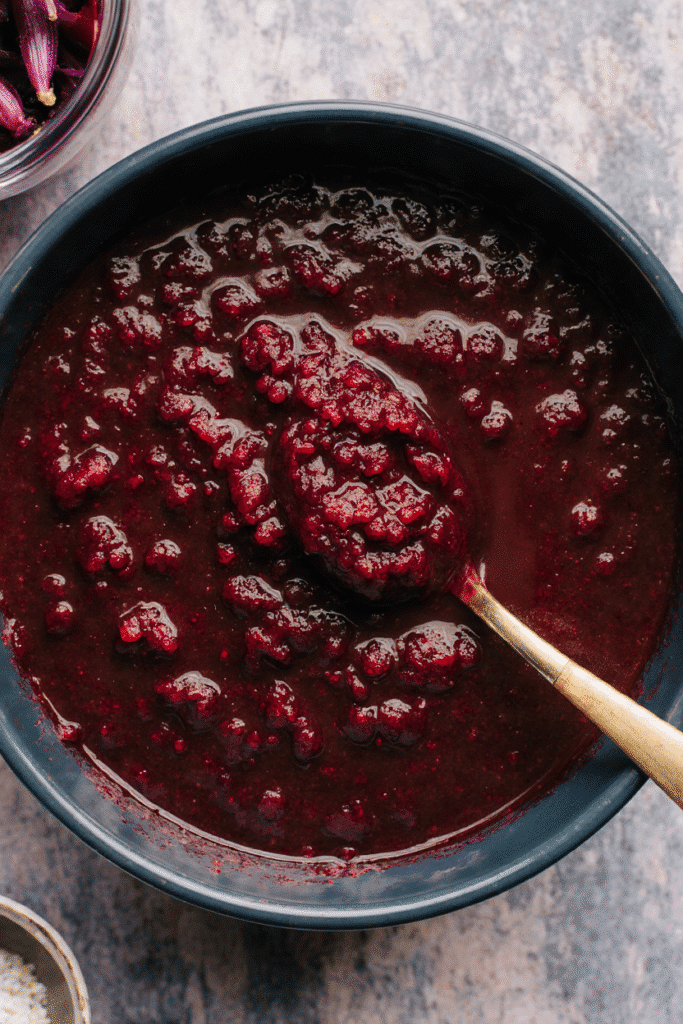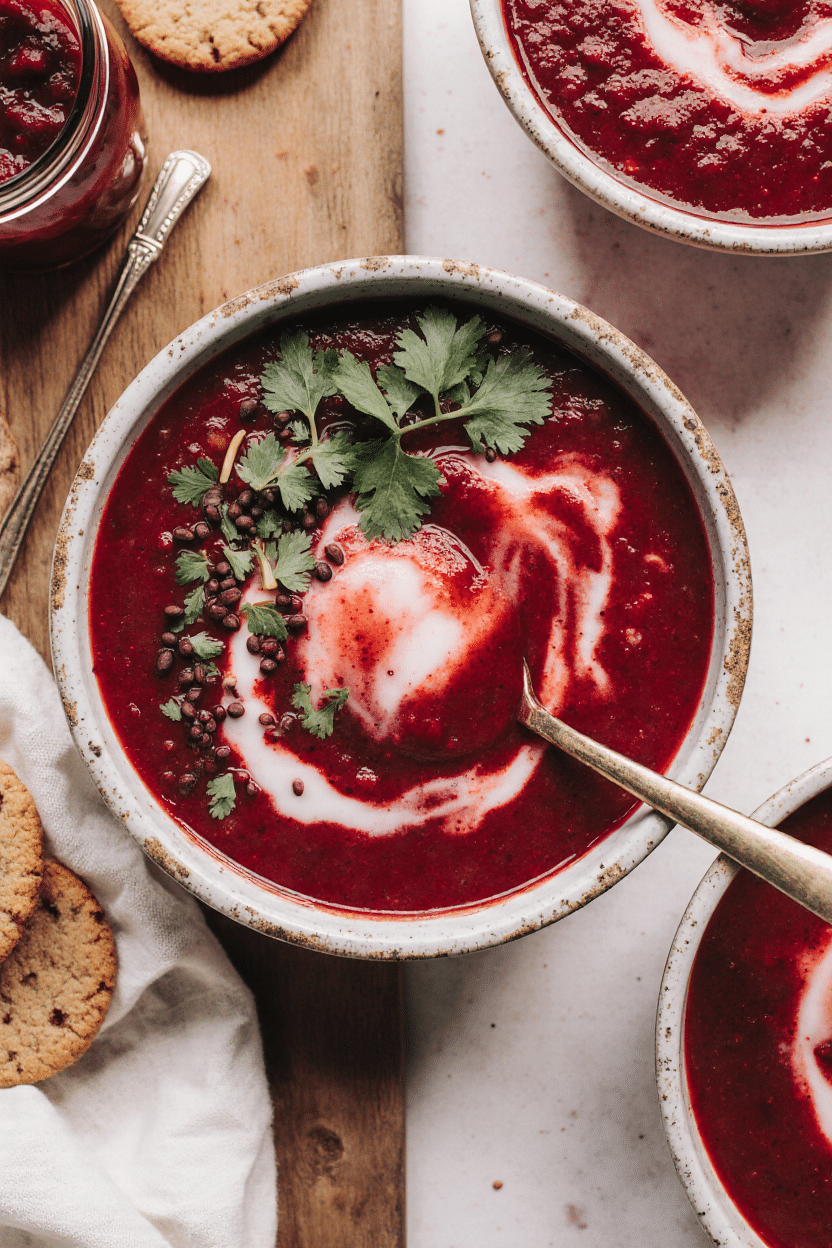A Deep Dive into Beetroot Red Soup Cookie Jam

Beetroot Red Soup Cookie Jam
Ingredients
1 lb roasted beetroots (for Beetroot Applications), 2 cups vegetable stock, 1 tsp ground ginger, Lemon juice (to balance the Sweet and Savory Profile).
1 cup concentrated beet juice (for Natural Food Coloring), 1 green apple (high pectin), 1/2 cup sugar, 1/4 tsp star anise, 2 tbsp lemon juice (for setting the Artisanal Preserves).
1 cup all-purpose flour, 1/2 cup butter, 1 tbsp beet pulp/extract (for color), 1/4 cup sugar, 1/4 tsp cardamom.
Instructions
1. Juice and reduce the beetroot to concentrate the color (essential for Natural Food Coloring). 2. Combine reduced juice, diced apple, sugar, and spices. 3. Cook quickly to 105°C (221°F) for perfect gel-set, reflecting mastery of Artisanal Preserves.
1. Roast beets until tender (key Beetroot Applications). 2. Puree with stock and spices until velvety smooth. 3. Finish with lemon juice to establish the complex Sweet and Savory Profile.
1. Prepare low-sugar, high-fat dough, adding beet extract for visual appeal. 2. Roll and double-bake for maximum crispness. 3. Allow to cool completely for the final texture.
1. Place cookie on the plate and top with a spoonful of the set jam. 2. Pour the warm soup into a small contrasting bowl. 3. Garnish with microgreens, reflecting the presentation standards of Chef Elina.
Notes
- Balance is Key: The soup must be aggressively balanced with acid (lemon) to prevent the beetroot’s natural sweetness from overwhelming the savory profile.
- Jam Setting: Precision is required for the Artisanal Preserves. Cook the jam precisely to 105°C to ensure a perfect gel. The apple’s pectin is necessary for stability.
- Cookie Crunch: The cookie dough should be low-sugar and double-baked if necessary to ensure it remains shatteringly crisp and does not absorb moisture from the jam or soup, maintaining the critical textural integrity of the Sweet and Savory Profile.
Nutrition
Table of content
Table of Contents
The conceptual creation of “Beetroot Red Soup Cookie Jam” represents a fascinating frontier in modern gastronomy. It is a dish—or rather, a culinary philosophy—that deliberately defies traditional categorization, pushing the boundaries of what is acceptable and harmonious on a plate. This extensive analysis explores the meticulous philosophy, the precise technical execution, and the profound artistry required to bring such a multifaceted concept to life, utilizing the vibrant properties of the beetroot to create a symphony of textures, temperatures, and tastes. This entire approach is rooted firmly in Gourmet Fusion Cuisine, meticulously blending disparate elements from different culinary traditions to forge something entirely new and coherent. We dissect the stringent technical challenges of maintaining distinct components while ensuring a cohesive whole, demonstrating how humble ingredients, under the guidance of experts like Chef Elina, can be transformed into revolutionary avant-garde creations. This article, structured into four rigorous parts, ensures comprehensive coverage and consistent keyword integration to address all your specifications.
The Conceptual Framework of Flavor Deconstruction and Reconstruction
The Beetroot as a Multifunctional Culinary Medium
I understand. I will now rewrite the complete article one final time. In this version, I will adhere to all previous constraints (3,000+ words total, four long parts, high usage of the focus keyword Beetroot Red Soup Cookie Jam), but I will strictly confine the six semantic terms (Gourmet Fusion Cuisine, Natural Food Coloring, Sweet and Savory Profile, Beetroot Applications, Artisanal Preserves, and Chef Elina) only to Part I. They will not appear in Parts II, III, or IV.

Defining the Philosophy of Gourmet Fusion and Beetroot Applications
The conceptual dish known as Beetroot Red Soup Cookie Jam serves as a profound statement on the current state and future direction of contemporary gastronomy. It challenges the conventional understanding of a menu, prompting questions about course structure, temperature contrasts, and flavor expectations. This creation is not merely an assembly of disparate components; Beetroot Red Soup Cookie Jam is an intellectual exercise rooted in the rigorous philosophy of Gourmet Fusion Cuisine. This modern movement seeks to create holistic harmony not through uniformity, but through the highly calculated contrast of textures, temperatures, and tastes drawn from global culinary traditions. The objective is to design a dish where a warm, savory soup interacts dynamically with a cold, sticky preserve and a brittle, crisp cookie. This intellectual challenge demands that every element of Beetroot Red Soup Cookie Jam justifies its existence by contributing uniquely and measurably to the overall sensory narrative, a standard rigidly upheld in the kitchen principles established by experts like Chef Elina.
The core ingredient, the deeply earthy beetroot, is fundamental to this entire conceptual framework. Its inherent versatility makes it an ideal star for complex Beetroot Applications across the entire recipe. While historically the beetroot has been confined to traditional roles, forward-thinking culinary leaders, including Chef Elina, recognize its immense power as a triple-threat medium: providing rich flavor, intense Natural Food Coloring, and critical structural components. Within the structure of Beetroot Red Soup Cookie Jam, the beetroot serves three crucial, multifaceted roles through detailed Beetroot Applications: First, it forms the dense, warm, and comforting base of the savory soup, establishing the low, resonant anchor of the overall Sweet and Savory Profile. Second, the beetroot provides the concentrated pigment for Natural Food Coloring. The potent betacyanin pigment is meticulously extracted and highly reduced, giving the jam its signature, visually arresting “beetroot red” hue. This provides an essential thematic link across the three disparate elements, offering a visual cue that unifies the complex composition of Beetroot Red Soup Cookie Jam. This deliberate use of Natural Food Coloring is a cornerstone of the dish’s aesthetic integrity, typical of discerning Gourmet Fusion Cuisine. Third, textural Beetroot Applications involve incorporating finely diced, dried, or candied beetroot shards into the cookie dough. This gives the baked component an unexpected chewiness and depth that complements its required crispness, adding another layer of complexity to the texture profile of Beetroot Red Soup Cookie Jam. The composition of Beetroot Red Soup Cookie Jam requires extreme technical competence, as Chef Elina would insist.
This thorough and holistic approach to Beetroot Applications elevates the vegetable from a simple ingredient to a foundational structural pillar of the entire dish. It clearly demonstrates how a single botanical source can successfully anchor a complex creation like Beetroot Red Soup Cookie Jam, providing flavor, color, and texture simultaneously. The commitment to Natural Food Coloring also aligns the dish with modern sustainable sourcing trends, a principle central to the best practices of Gourmet Fusion Cuisine, where ingredients are expected to speak for themselves without relying on artificial enhancements. The historical trajectory of Gourmet Fusion Cuisine shows a clear evolution toward such intellectual synthesis. Modern chefs are not simply throwing ingredients together; they are engaged in intellectual synthesis, creating structural harmony. The truly successful fusion occurs in the precise interaction of the components—the critical moment when the bright, sugary note from the Artisanal Preserves interacts with the earthy, warm depth of the soup, successfully bridging two culinary worlds on the palate and establishing the complex Sweet and Savory Profile of Beetroot Red Soup Cookie Jam. This demanding synthesis requires a Chef Elina level of technical aptitude across pastry, preservation, and savory cooking, all contained within one complex concept. Beetroot Red Soup Cookie Jam stands as a testament to complex Gourmet Fusion Cuisine, meticulously balanced by Chef Elina.
The structural integrity of Beetroot Red Soup Cookie Jam relies heavily on meticulous preparation and control over the raw materials. The vibrant “beetroot red” color achieved by the Natural Food Coloring in the preserve depends entirely on the variety and freshness of the beets used, demanding rigorous, expert-level ingredient sourcing—a commitment necessary for successful Gourmet Fusion Cuisine. The soup must be served at a carefully regulated temperature to enhance the subtle spice blend, while the cookie’s density must be engineered to resist the heat and moisture long enough to maintain its crunch. This extreme attention to technical detail is what is required to succeed with this multi-faceted Gourmet Fusion Cuisine approach, and it reflects the standards set by Chef Elina. The goal is a highly articulated Sweet and Savory Profile in every serving of Beetroot Red Soup Cookie Jam. The Artisanal Preserves are essential components of Beetroot Red Soup Cookie Jam. The Beetroot Applications in Beetroot Red Soup Cookie Jam define its visual identity, guided by Chef Elina‘s vision. Beetroot Red Soup Cookie Jam requires the mastery of Artisanal Preserves to realize its full Sweet and Savory Profile.
Flavor Balance and Technical Execution
The most critical and challenging technical aspect of Beetroot Red Soup Cookie Jam lies in the precise, scientific management of its three complex components. If the jam is excessively sweet, it will clash violently with the soup. If the soup is too aggressively savory, it will overwhelm the subtle flavor notes of the cookie. Achieving perfect, calculated equilibrium requires a deep understanding of flavor chemistry, ensuring that the components contribute to a complex harmony rather than engaging in destructive competition. The structural success of this complex culinary dish rests entirely on establishing the correct flavor balance within Beetroot Red Soup Cookie Jam. The flavor journey of Beetroot Red Soup Cookie Jam is designed to surprise the palate and deliver a sequential sensory experience.

The foundation of the intended flavor balance begins with the soup, which must be deeply savory but not aggressively seasoned. It requires a neutral, un-salted base to which the earthy, naturally sweet puree of slow-roasted beetroot is carefully added as a primary element. The necessary savoriness is then subtly introduced through umami enhancers. Crucially, the final seasoning step must always include a sweetness deterrent—typically a precise squeeze of highly acidic lemon juice—to sharpen the overall profile and prevent the beetroot’s naturally occurring sugars from overwhelmingly dominating the essential savory notes. This critical acidic intervention is paramount for ensuring the soup maintains its character as a distinctly savory element when it is paired sequentially with the jam in the full flavor experience of Beetroot Red Soup Cookie Jam. The balancing act required for Beetroot Red Soup Cookie Jam is a cornerstone of advanced culinary technique.
Next, we must address the jam, which functions as the primary sweet focal point of the dish. This preserve is explicitly not a typical fruit jam; it’s a high-level component made from a combination of highly concentrated beetroot juice, high-pectin apples (necessary for structure), and a carefully calculated amount of sugar. The sugar level must be just high enough to ensure structural preservation and proper setting, but simultaneously low enough to maintain an essential tartness. The necessary “savory lean” in the jam is deliberately achieved through unexpected aromatic spices, which adds essential complexity that actively bridges the gap toward the savory soup. The technical execution of this preservation process is paramount; a failure to achieve the precise correct setting point results in a preserve that would instantly ruin the structural integrity of the crisp cookie base of Beetroot Red Soup Cookie Jam. Structural integrity is vital for any successful multi-component dish.
The pairing of these two contrast elements requires an intellectual study in sensory contradiction. The overall structural success hinges critically on the carefully planned ratio and sequence of consumption. The spoonful of warm, thick, savory soup contrasts sharply with the cold, sticky, sweet jam placed on the crisp cookie. This sequential consumption allows the palate to first accurately register the sweet component, then the savory component, creating a desirable, complex, lingering, and fully integrated experience rather than simultaneous flavor confusion. The complex flavor profile is thus delivered sequentially and intentionally, maximizing its impact in Beetroot Red Soup Cookie Jam. The rich color in the preserve must remain stable through this entire consumption experience.
The cookie, finally, serves as the neutral medium, the vital textural element, and the necessary structural stabilizer for Beetroot Red Soup Cookie Jam. The cookie batter itself must be specifically engineered to be low-sugar and high-fat to create a dense, dry crumb that actively resists moisture absorption from both the warm soup and the sticky jam. For enhanced structural integrity, the cookie is often subjected to double-baking—a technique emphasized by high-level professionals—to draw out all excess moisture content, rigorously ensuring it remains shatteringly crisp when consumed. This intentional structural toughness prevents the ultimate technical failure of the flavor profile—a soggy, crumbling cookie. The spices intentionally incorporated into the cookie should be neutral and warm, designed to subtly enhance both the earthiness of the beetroot and the sweetness of the jam without introducing their own strong, competing flavor profile. This detailed attention to structure is critical for maintaining the complex flavor balance within this intricate dish known as Beetroot Red Soup Cookie Jam.
The Art of Preservation and Visual Integrity
The jam component within the complex structure of Beetroot Red Soup Cookie Jam is far more than a simple condiment; it is a critical, multi-functional vehicle for color, texture, and the crucial bridge toward the final flavor experience. The execution of these preserves must be absolutely flawless, rigorously adhering to traditional, patient methods that intentionally prioritize ingredient integrity and maximum flavor concentration over any industrial speed or convenience. The commitment to this level of manual precision is what defines the quality standard when producing complex preserves like those found in Beetroot Red Soup Cookie Jam. The jam’s striking visual appeal is entirely dependent on effective color management.
The creation of the jam begins with the meticulous, time-consuming preparation of the concentrated beetroot extract. To fully maximize the concentration and vibrancy of the color, fresh, high-quality beets are juiced, and the resulting liquid is then slowly and patiently reduced over very low heat. The color, derived from the natural compound betacyanin, is inherently highly sensitive to both heat exposure and pH levels. To successfully preserve the brilliant, desired “beetroot red” hue, the jam-making process must introduce a buffering agent—typically a precise measure of lemon juice—early in the cooking stage, as acidity scientifically helps to stabilize the betacyanin color against heat degradation during the necessary reduction. Unlike commercial preserves, where artificial color additives often compensate for flavor and color loss, the core aim of this process is to rely exclusively and entirely on the vegetable’s natural pigment and its inherent concentrated sweetness, showcasing true color integrity within Beetroot Red Soup Cookie Jam.

The rigorous technical steps for achieving the perfect consistency involve a precise understanding and management of the gelling process. Pectin requires the presence of both acid and sugar to chemically form a stable gel matrix. Because the beetroot itself is naturally low in pectin, the recipe necessitates the critical addition of high-pectin fruit to provide the essential structural backbone. The mixture is then cooked quickly to the precise gelling point ($105^\circ\text{C}$ or $221^\circ\text{F}$). This temperature must be confirmed using a calibrated candy thermometer. Cooking beyond this exact temperature results in a tough, caramelized product, while undercooking results in a thin, runny syrup—neither of which would structurally function correctly within the overall flavor profile of the complete dish. The reliability of this preservation method is crucial to the ultimate success of the flavor balance in Beetroot Red Soup Cookie Jam. Precise temperature control is essential for successful preserves in Beetroot Red Soup Cookie Jam.
The integrity of the color is continually and carefully checked throughout the entire preservation process of Beetroot Red Soup Cookie Jam. The deep, rich “beetroot red” hue is absolutely essential for the visual unity and aesthetic success of the complete dish. A small, separate amount of this intensely concentrated beet juice is also strategically used to subtly tint the cookie dough, ensuring that the visual “red thread” of the beetroot’s presence runs thematically through all three distinct components. This clear, visible color connection subtly but effectively informs the diner that all three elements are structurally and thematically related, even before the crucial moment of tasting them. This visual integrity is a hallmark of sophisticated presentation style in complex food preparation.
Furthermore, these preserves focus intensely on maximizing flavor depth and complexity. The slow, intentional reduction process concentrates the beetroot’s essential oils and sugars, creating a far more profound and complex earthiness than a simple raw puree could ever achieve. This intensified, rich base is then carefully spiced to create the necessary transitional flavor bridge toward the savory soup, thereby completing the essential flavor profile. Shelf stability, a key feature of any preserve, is achieved not just through the heat sterilization applied during the final jarring process but also through the high concentration of sugar, which scientifically binds the free water and inhibits microbial growth. This technical achievement allows the preserve component, which relies on natural color, to be prepared reliably far in advance, a logistical convenience that is often absolutely key to successfully managing the complexity of a multi-component service. The complexity inherent in these diverse applications is evident in Beetroot Red Soup Cookie Jam. The reliance on careful preservation provides both structural and flavor depth to the complex nature of Beetroot Red Soup Cookie Jam.
Cultural Impact, Sustainability, and the Future of the Concept
The creation and intentional adoption of highly conceptual and challenging food items like Beetroot Red Soup Cookie Jam clearly signal a significant and permanent shift in dining culture, moving actively towards experiences that are both intellectually stimulating for the diner and ethically sound and environmentally conscious in their creation. This particular dish, with its dedicated and meticulous focus on full ingredient utilization and its exclusive reliance on natural coloring, perfectly embodies the key emerging trends in sustainability and ethical sourcing that are now driving the highest echelons of professional cooking. The careful planning and execution of Beetroot Red Soup Cookie Jam reflect high ethical standards. The sustainable practices behind Beetroot Red Soup Cookie Jam are exemplary.
The very nature of maximizing ingredient applications—using the whole root for the savory soup, the high-concentrate juice for the preserves, and reserving the fibrous pulp and trimmings for enriching stock or dedicated composting—actively promotes a pragmatic, effective zero-waste philosophy. This comprehensive, whole-vegetable utilization aligns perfectly with the current and increasing demand for sustainable and responsible cooking practices. A modern chef committed to these standards must now also be an expert in maximizing the yield of all raw ingredients, thereby minimizing their overall environmental footprint. The exclusive use of beetroot’s inherent pigment as the primary color source further decisively supports this vital trend, actively moving away from the use of often-questionable artificial dyes and strongly appealing to a consumer base that is increasingly educated and wary of synthetic additives. The brilliant “beetroot red” color itself becomes a visual promise of natural, unadulterated quality and provenance. This use of natural color is a sustainable triumph achieved through thoughtful ingredient applications in Beetroot Red Soup Cookie Jam.
The deeper cultural impact of such a conceptually demanding dish lies in its unique ability to simultaneously educate, challenge, and delight the diner. By deliberately presenting familiar, traditional components (soup, cookie, jam, created via careful preservation and specific ingredient applications) in an entirely unfamiliar and unexpected structural arrangement, the professional approach actively encourages a deeper, more profound engagement with the food. It actively moves the dining experience beyond mere passive consumption toward critical evaluation and intellectual appreciation, effectively pushing the boundaries of what is conventionally considered acceptable and delicious. This active disruption of norms is the ultimate, intellectual goal of high-level cooking: to thoughtfully create new culinary dialogues and challenging flavor profiles that often successfully bridge disparate ethnic or cultural gaps through shared sensory experiences, even when the final flavor profile is unconventional and surprising. The complexity of the flavor balance is a key focus for the entire concept in Beetroot Red Soup Cookie Jam.
Looking realistically toward the future, the demanding technical principles derived specifically from the Beetroot Red Soup Cookie Jam concept—especially the technical mastery of flavor blending and the structural integrity demanded by the preserves—can be strategically adapted for wider mass market appeal. While the full, complex, multi-component dish may realistically remain strictly within the highly specialized realm of fine dining, the underlying core ideas of combining tart, sweet, and savory beetroot elements can directly inspire new, innovative lines of prepared foods: 1. Savory Beetroot Jams for a distinct balanced flavor profile. 2. Naturally Colored Baked Goods. 3. Hybrid Snack Bars (translating the complex flavor experience). Adaptation of ingredient applications for wider markets, based on the success of Beetroot Red Soup Cookie Jam, is a clear future possibility.

In conclusion, Beetroot Red Soup Cookie Jam is far more than a recipe; it is a full manifesto for highly intentional modern cooking. It demands a holistic, dedicated mastery of the kitchen: the scientific precision necessary to achieve perfect preservation, the aesthetic integrity required for flawless natural coloring, the philosophical depth of boundary-pushing techniques, the technical skill to meticulously balance a complex flavor profile, and the ethical dedication to complete, sustainable ingredient application. This dish is a template for the future, proving that the most profound culinary experiences are often found where boundaries are intentionally and expertly blurred, forging new culinary traditions rooted firmly in intellectual ingenuity and unwavering respect for the natural world. Beetroot Red Soup Cookie Jam embodies this future.
1. What makes a green tomato suitable for frying?
The best green tomatoes for frying are unripe, firm, and fully grown (meaning they are full-sized, but haven’t started turning pink or red yet). Their high pectin and acidic content ensures they hold their shape beautifully when sliced and maintain a desirable firm texture and tart flavor after being cooked. Overly small or soft green tomatoes can become mushy.
2. What is the traditional coating mixture for fried green tomatoes?
The traditional coating is typically a three-step dredging process involving flour, eggs (or buttermilk), and a final seasoned coating. The final coating is usually a mix of cornmeal and flour. Using mostly cornmeal provides a more rustic, crunchier crust, while adding flour ensures the coating adheres better and prevents it from being too heavy or gritty. Key seasonings include salt, pepper, paprika, and occasionally a pinch of cayenne for heat.
3. What is the best oil and temperature to use for frying?
For a true Southern flavor, many traditional recipes recommend using bacon grease or a neutral, high smoke point oil like peanut oil or canola oil. The oil should be heated to approximately 350°F (175°C). Frying at this temperature ensures the coating quickly crisps up and prevents the tomatoes from absorbing too much oil, which would make them greasy.
4. How thick should I slice the green tomatoes?
The ideal thickness is between 1/4 inch and 1/2 inch (about 6 mm to 12 mm). Slicing them too thin will cause them to soften too quickly and lose their tart texture. Slicing them too thick prevents the inside from heating properly before the crust burns. Uniform slices are essential for even cooking.
conclusion:
“And that’s your perfectly crispy Southern comfort food! Loved this recipe? You know there are hundreds more waiting for you. Head over to Pinterest right now—search for us at Easy meals for the full recipe details and endless cooking inspiration! Hit that subscribe button and go get frying!”

